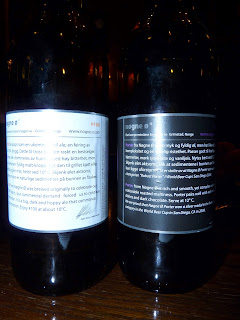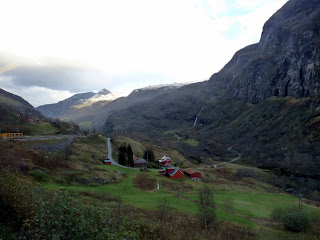We arrived in the Norwegian capital after a scenic six hour train ride from Stockholm. The area around Oslo's central train station is, somewhat surprisingly, a bit seedy. On the short walk to our hostel, we were approached by several people of dubious intent. Even the receptionist told us that lots of drug addicts "live" in the hostel where we were booked so we were thankful to be "upgraded" to their sister hotel next door. Note that drug addicts are allowed to hang out around the train station because the government has realized it cannot eliminate the problem so thus tries to confine it to one small area of the city.
 |
| outside Oslo's train station |
The following morning, we were pleasantly surprised by the huge breakfast buffet offered by our hotel. We had booked the cheapest accommodation we could find in the city center ($125 per night including breakfast) so had not expected anything more than the typical cold meat, cheese & bread. But we were overwhelmed by the scrambled eggs, sausages, roasted potatoes and baked beans, not to mention the wide assortment of cold salads, yogurts, pickled herring, etc.
 |
| a "budget" dinner |
This turned out to be quite a blessing because food in Norway is heart-stoppingly expensive. For starters, you have to pay more to eat in a restaurant versus takeaway (25% tax for eating in versus 12% for takeaway). Trying to save money, we bought pre-made sandwiches and a can of Pringles at the grocery store; the total cost was still $20. We did find a budget Vietnamese restaurant near our hotel where the average entree cost 90NOK ($17). But most restaurant entrees (still not high-end ones) were priced from 129NOK ($23) and up.
 |
| the cheapest restaurant we could find in Oslo -- thankfully it had very good Vietnamese & Thai food |
As in Sweden, the sale of alcohol is controlled by the state, so you have to shop at Vinmonopolet if you want something stronger than 3.5% ABV. They have a great selection, but unless you want to pay, for example, almost $100 for a one liter bottle of Jameson (versus about $25 at home), I would plan on abstaining while in Norway. We did indulge our craft beer fancy one time, buying two bottles of Nogne-O (Porter & 100) on our last night in the country for 144NOK ($24).
 |
| yummy Nogne-O beers for $12 each |
Besides using our Rick Steves guidebook's self-guided walking tour to get a glimpse of Oslo's most interesting sights, we also found plenty of other enjoyable ways to explore the city without having to spend any money: Oslo Cathedral, City Hall, strolling the Akershus Fortress grounds, Frogner Park, the Vigeland Museum (free during winter months), the path along the Akers River gorge, and the new Opera House. In addition, the National Gallery (with it's Munch Room) is free on Sundays. We did pay 50NOK ($9) each to visit the Norway Resistance Museum. While it was interesting enough, I would only recommend it for World War II history buffs.
 |
| I loved Gustav Vigeland's sculptures in Frogner Park |
One of my stipulations for our travels in Northern Europe was that we had to see the Norwegian fjords. This proved to be more difficult than I expected since we were traveling in the off season. While the standard "Norway in a Nutshell" itinerary is available year-round, is is much harder to deviate off the beaten path outside of May to September. Not wanting to rush through this beautiful area (the Nutshell itinerary can be done in 24 hours), we decided to break up the journey with an overnight stop in Flam.
 |
| all aboard! |
The first segment of the Nutshell itinerary involves taking a scenic five hour train ride from Oslo to Myrdal. The "best" scenery started about 2.5 hours into the trip, when the train began to wind its way up through the mountains, passing forests & lakes. We reached the snow line about 1.5 hours later and by the time we passed through Finse (at 1,222 meters the highest point on the Bergen Railway) we were in a winter wonderland.
 |
| near Finse on the Bergen Railway |
In Myrdal we transferred to the Flam Railway (Flamsbana). It takes about one hour to descend the 20km of track from 866 meters to 2 meters, criss-crossing the Flam valley. The breathtaking Norwegian mountain landscape is replete with waterfalls; the train even stops briefly at one so you can get out and take pictures.
 |
| view from the Flamsbana |
Flam in the off-season is about as quiet as you can get. It's a tiny village at the head of the Aurlandsfjiord with just a handful of hotels & restaurants. As it was mid-October, virtually everything was closed (or else had very short opening hours). With limited options, we had to fork over $160 for a night in a budget hotel and a whopping 365NOK ($65) for two simple fish & chips dinners (along with Aegir beers - yes, Flam has it's own microbrewery!).
 |
| view of the Aurlandsfjord from the village of Flam |
Our Nutshell journey continued the following day with a two hour fjord cruise from Flam to Gudvangen. It had been raining off & on all morning but luckily cleared up a bit for our afternoon cruise through the Aurlandsfjord and Naeroyfjord, both arms of the Sognefjord. Still, we wore our full Goretex rain gear to stay warm in the damp & chilly fjord air as I couldn't resist standing outside to take photos of the beautiful scenery during most of the trip.
 |
| cruising the Naeroyfjord |
From Gudvangen we traveled by bus (1 hour) to Voss where we caught a train (another hour) to Bergen. The sun had long since set, so I can't say much about the scenery on this leg of the journey. Luckily, it was barely sprinkling when we finally arrived in Bergen around 8:30pm. After a steep uphill hike from the train station to our hotel, we were rewarded with a huge room overlooking the lake (perhaps because I had notified them in advance that we were on our honeymoon).
 |
| steep streets of Bergen |
One day was all we needed to sightsee in Bergen. We weren't particularly interested in the museums, having visited so many around the world over the past year, so we simply took a long walk around the university area near our hotel, then down to the harbor, along the historic Hanseatic quarter (Bryggen), circling the Bergenhus (old fortress), wandering through the residential area near the Domkirken (12th-13th century cathedral) and back to the train station. We bought dinner provisions from the grocery store, supplemented by a vegetarian entree from a Thai restaurant, then enjoyed our feast in the beautiful dining room of our hotel. The total cost of our budget meal, excluding those two Nogne-O beers I mentioned earlier, was still $40.
 |
| Bryggen rooftops |
Despite our multiple cost-saving measures, Norway turned out to be the most expensive country we've ever visited. The transportation alone for our Norway in a Nutshell itinerary cost $450 for two people. We only spent six nights in Norway, but burned through $1650, an average of $138 per person per day. By comparison, in Japan, the most expensive country we visited independently during our round-the-world trip, we only spent an average of $105 per person per day. As with Sweden, though, if you have the time & money, I would still recommend a trip to this beautiful country.
Here are the links to all of my Norway photos:
Oslo
Mountains & Fjords
Bergen
Facebook Favorites